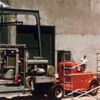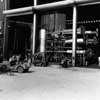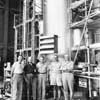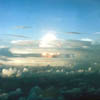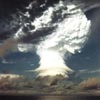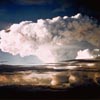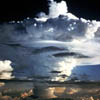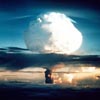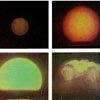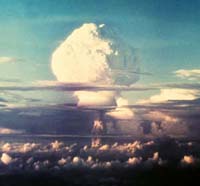 On the 31st of January 1950, President Harry S. Truman publicly declared the U.S. intention to develop a hydrogen bomb. This declaration was largly motivated by growing fears that the United States being overtaken in a nuclear arms race by the Soviet Union. The detonation of the Soviet Union's first nuclear bomb, and the discovery of Klaus Fuchs' espionage activity of at Los Alamos uncovered just days before Trumans announcment, contributed greatly to this fear.
On the 31st of January 1950, President Harry S. Truman publicly declared the U.S. intention to develop a hydrogen bomb. This declaration was largly motivated by growing fears that the United States being overtaken in a nuclear arms race by the Soviet Union. The detonation of the Soviet Union's first nuclear bomb, and the discovery of Klaus Fuchs' espionage activity of at Los Alamos uncovered just days before Trumans announcment, contributed greatly to this fear.
The highest priority was placed on developing new and more potent strategic weapons - especially thermonuclear weapons (hydrogen bombs). Thermonuclear weapon design was still theortical, so a fallback strategy was pursued of developing the highest yield fission bomb possible, a technical effort led by Theodore Taylor at Los Alamos. The conceptual breakthroughs of Stanslaw Ulam and Edward Teller the following January provided the needed insights to develop a thermonuclear device.
From early 1951 onward, two parallel efforts to develop high yield weapons were focused on a Pacific Proving Ground test series for late in 1952. This series known as Operation Ivy, exploded the two largest bombs tested up to that time. It heralded the beginning of the thermonuclear age with the first "true" thermonuclear test, which was more powerful than all the explosives used in the two World Wars put together. Ivy also tested the highest yield pure fission weapon ever exploded. The names of the shots were designated Mike ('M' for megaton), and King ('K' for kiloton).
"It is part of my responsibility as Commander in Chief of the Armed forces to see to it that our country is able to defend itself against any possible aggressor. Accordingly, I have directed the AEC to continue its work on all forms of atomic weapons, including the so-called hydrogen or Super bomb."
- President Harry S. Truman, 31 January 1950
|
Joint Task Force 32 (JTF 132) was the organization responsible for conducting the Ivy test series. Elements of the four services, the AEC, and government contractors made up this organization. The joint nature of this test organization resulted from the requirements of the Atomic Energy Act 1946. This legislation placed atomic energy development under civilian control; however, the remoteness of the IVY Series test site required a military organization for physical security, as well as technical and logistical support.
The total number of personnel involved in the task force was 11, 650, of which 9,350 were military and 2,300 were civilians. Most of the civilians and over 6,600 of the military personnel operated from Enewetak Atoll and from task force ships that were based there. Most of the remaining military were Air Force personnel who were based at Kwajalein.
The Tests
Mike

Ivy Mike - 31/10/1952
|
Mike was not a a weapon in the conventional sense, rather the huge shot cab was a factory for producing an explosion. The device nicknamed the 'Sausage', was the first "true" thermonuclear device, built on the Teller-Ulam principles of staged radiation implosion. The device was designed by the Panda Committee directed by J. Carson Mark at Los Alamos. Edward Teller declined to play a role in its development, or observe the test. However he did monitor the detonation using seismic equipment from his lab in California 8,000 kilometers away.
Mike used deuterium (an isotope of hydrogen) as its fusion fuel, maintained as a liquid at -250 c by an expensive and cumbersome cryogenic system. The device had two stages, the primary stage , a TX-5 fission bomb, and a secondary stage consisting of the liquid deuterium stored in a cylindrical Dewar (thermos) flask. The Dewar was surrounded by a massive natural uranium casing weighing more than five tons. The function of this uranium tamper/pusher was to contain the secondary and delay it's destruction, and to act as a pusher, smoothly transfering the energy from the primary.
The entire assembly was housed in an enormous steel casing, 2 meters wide and 6 meters long, with 30 cm thick walls, the largest single forging made up to that time. The inside surface of the casing was lined with sheets of lead and polyethylene to form the conduit that carried x-ray radiation from the primary to the secondary. These x-rays would heat the the surface of the uranium pusher sufficiently that it would ablate, boiling vapourised uranium off it's outer surface. The ablating vapour would function like a rocket accelerating the pusher shell inward compressing the deuterium.
Additionally the deuterium was compressed from the inside by a plutonium rod running down the center of the assembly. This fission "spark-plug" was ignited by direct energy from the primary, "sandwiching" the deuterium and creating the vast pressures and temperatures required to fuse the deuterium atoms creating a sustained thermonuclear reaction. The entire device weighed 82 tons, housed within a three story building known as the shot cab.
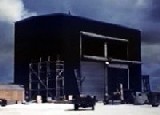
The Mike shot cab
|
A 2,800 meters long causeway was built from Elugelab across Dridrilbwij and Bokaidrikdrik to Boken. The causeway provided a road between ground zero on Elugelab, the temporary support camp on Dridrilbwij, and major scientific stations on Boken. It also supported a plywood, helium-filled conduit (Krause-Ogle Box) extending from the Mike shot cab, to the scientific stations on Boken. This box allowed gamma and neutron radiation from the blast to travel with as little absorption as possible to the test instruments.
In total, 9,350 military and 2,300 civilian personnel were involved in the Mike shot. A large cryogenics plant was installed on Parry Island, at the South end of the Eniwetak atoll, to produce the liquid hydrogen (used for cooling the device) and deuterium needed for the test.
Mike was detonated at 11:30 local time with a yeild of 10.4 megatons. The novelty of the experiment made accurate yield prediction difficult, however the device designers expected a yield of at least 4 Mt assuming a fusion reaction could be triggered. The actual yield was in excess of 10 megatons, the 4th largest device ever tested by the U.S. 8 megatons (77%) of the yield was due to fast fissioning of the natural uranium pusher/tamper, with the remaining 2.4 megatons coming directly from fusion of the deuterium fuel.
The island of Elugelab that the test device was installed on was completely destroyed. The resulting underwater crater was 1.9 kilometers across and 50 meters deep, large enough to hold 14 buildings the size of the Pentagon. The heat generated by the detonation charred the leaves of plants on Bijire 10 km away. The closer islands, Boken, Bokaidrikdrik and Dridrilbwij, were completely swept clean.
"Something I will never forget was the heat. Not the blast...the heat just kept coming, just kept coming on and on. Its really quite a terrifying experience because the heat doesn't go off....on kiloton shots its a flash and its over, but on those big shots its really terrifying."
- Harold Agnew, Observing from a ship 40 km away
|
The mushroom cloud climbed to 17,300 meters in only 90 seconds, entering the stratosphere. One minute later it reached 33,000 meters, eventually stabilizing at a ceiling of 36,500 meters. Half an hour after the test the mushroom stretched 96 kilometers across, with the base of the mushroom head joining the stem at 13,700 meters. Powered largely by fission, Mike showered vast amounts of highly radioactive fallout over the atoll.
Following this successful test, the Mike design was weaponized as the EC-16 (EC-Emergency Capability), but it was quickly abandoned for solid-fueled designs after the success of the Castle Bravo shot. Jimmy P. Robinson, a USAF captain, was lost while piloting his F-84G through the mushroom cloud to collect air samples; he ran out of fuel and attempted to land on water but was never found.
King
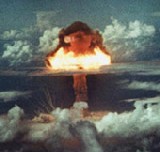
King Ivy - 14/11/1952
|
Ivy King was the largest pure fission nuclear bomb ever tested by the United States. The production of Ivy King was hurried so it would be ready if its sister project, Ivy Mike, failed in its attempt to achieve a thermonuclear reaction. The Ivy King test actually took place two weeks after Mike. Unlike the Mike bomb, the Ivy King device could theoretically have been added to United States' nuclear arsenal because it was designed to be air-deliverable.
The device was a prototype of the Mk-18 Super Oralloy bomb. The device consisted mostly of standard stockpiled components - it was based on the stockpiled Mk-6D bomb, but using the 92 point implosion system developed for the Mk-13. The pit, consisting of the reflector and core, was heavily modified. The normal uranium-plutonium composite core was replaced by a new design made up of approximately 60 kilograms of highly enriched uranium (oralloy) in a natural uranium tamper. The complete bomb weighed 3.9 metric tons.
The Mk-18 bomb was developed under the direction of Ted Taylor at Los Alamos. A major aspect of the weapon development were the safety mechanisms. With such a large amount of fissile material (more than 4 critical masses), the bomb was skirting the edge of criticality safety. The highly enriched uranium (HEU) was fashioned into a thin-walled sphere ensuring that it remained sub-critical until imploded. The HEU sphere was then enclosed in a natural uranium tamper. To physically prevent the sphere collapsing into a critical mass if the surrounding explosives were detonated, or if it was crushed following an aircraft accident, the hollow center was filled with aluminium and boron chains. As well as physically preventing the collapse of the core, the chains absorbed the neutrons needed to drive the nuclear reaction further increasing safety. The chains were removed prior deployment as part of the arming process.
The shot was delayed for 24 hours due to bad weather. The live shot was preceded on the 8th November by a dummy run with a mock Mk-18 bomb. The target consisted of brightly painted oil drums mounted on pilings arranged in a cross and fitted with radar reflectors to improve accuracy. This target was visible from 40 kilometers away, the bomb was then aimed visually.
The weapon was successfully dropped by a B-36 at 11:30 local time, detonating 450 meters above the target area 610 meters north of Runit Island with a yeild of 500 kilotons. As it was an airburst, King produced relatively little fallout.
Damage from King was noted as far north of ground zero as Lojwa, where brush was scorched, and as far south as Jinedrol, where brush was burning. Closer in at Billae, palm trees were broken and burned. On Runit itself, power poles were downed and burning, and puddles of seawater were standing 400 meters inland, pushed there by the air blast.

| - DNA 6036F - Defense Nuclear Agency report - Ivy
|
|
- Click on a thumbnail for a larger version
|
|



 On the 31st of January 1950, President Harry S. Truman publicly declared the U.S. intention to develop a hydrogen bomb. This declaration was largly motivated by growing fears that the United States being overtaken in a nuclear arms race by the Soviet Union. The detonation of the Soviet Union's first nuclear bomb, and the discovery of Klaus Fuchs' espionage activity of at Los Alamos uncovered just days before Trumans announcment, contributed greatly to this fear.
On the 31st of January 1950, President Harry S. Truman publicly declared the U.S. intention to develop a hydrogen bomb. This declaration was largly motivated by growing fears that the United States being overtaken in a nuclear arms race by the Soviet Union. The detonation of the Soviet Union's first nuclear bomb, and the discovery of Klaus Fuchs' espionage activity of at Los Alamos uncovered just days before Trumans announcment, contributed greatly to this fear.


 The Mike shot cab
The Mike shot cab



